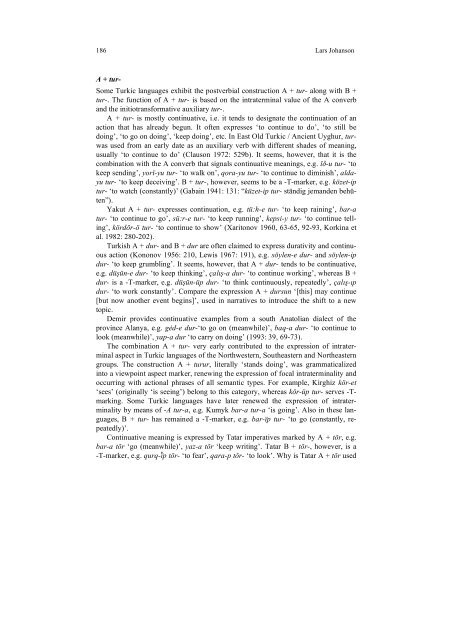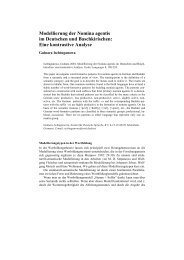On Turkic transformativizers and ... - Turkic Languages
On Turkic transformativizers and ... - Turkic Languages
On Turkic transformativizers and ... - Turkic Languages
Create successful ePaper yourself
Turn your PDF publications into a flip-book with our unique Google optimized e-Paper software.
186 Lars Johanson<br />
A + tur-<br />
Some <strong>Turkic</strong> languages exhibit the postverbial construction A + tur- along with B +<br />
tur-. The function of A + tur- is based on the intraterminal value of the A converb<br />
<strong>and</strong> the initiotransformative auxiliary tur-.<br />
A + tur- is mostly continuative, i.e. it tends to designate the continuation of an<br />
action that has already begun. It often expresses ‘to continue to do’, ‘to still be<br />
doing’, ‘to go on doing’, ‘keep doing’, etc. In East Old <strong>Turkic</strong> / Ancient Uyghur, tur-<br />
was used from an early date as an auxiliary verb with different shades of meaning,<br />
usually ‘to continue to do’ (Clauson 1972: 529b). It seems, however, that it is the<br />
combination with the A converb that signals continuative meanings, e.g. ïδ-u tur- ‘to<br />
keep sending’, yorï-yu tur- ‘to walk on’, qora-yu tur- ‘to continue to diminish’, aldayu<br />
tur- ‘to keep deceiving’. B + tur-, however, seems to be a -T-marker, e.g. közet-ip<br />
tur- ‘to watch (constantly)’ (Gabain 1941: 131: “küzet-ip tur- ständig jem<strong>and</strong>en behüten”).<br />
Yakut A + tur- expresses continuation, e.g. tü:h-e tur- ‘to keep raining’, bar-a<br />
tur- ‘to continue to go’, sü:r-e tur- ‘to keep running’, kepsi-y tur- ‘to continue telling’,<br />
kördör-ö tur- ‘to continue to show’ (Xaritonov 1960, 63-65, 92-93, Korkina et<br />
al. 1982: 280-202).<br />
Turkish A + dur- <strong>and</strong> B + dur are often claimed to express durativity <strong>and</strong> continuous<br />
action (Kononov 1956: 210, Lewis 1967: 191), e.g. söylen-e dur- <strong>and</strong> söylen-ip<br />
dur- ‘to keep grumbling’. It seems, however, that A + dur- tends to be continuative,<br />
e.g. düşün-e dur- ‘to keep thinking’, çalış-a dur- ‘to continue working’, whereas B +<br />
dur- is a -T-marker, e.g. düşün-üp dur- ‘to think continuously, repeatedly’, çalış-ıp<br />
dur- ‘to work constantly’. Compare the expression A + dursun ‘[this] may continue<br />
[but now another event begins]’, used in narratives to introduce the shift to a new<br />
topic.<br />
Demir provides continuative examples from a south Anatolian dialect of the<br />
province Alanya, e.g. gėd-e dur-‘to go on (meanwhile)’, baq-a dur- ‘to continue to<br />
look (meanwhile)’, yap-a dur ‘to carry on doing’ (1993: 39, 69-73).<br />
The combination A + tur- very early contributed to the expression of intraterminal<br />
aspect in <strong>Turkic</strong> languages of the Northwestern, Southeastern <strong>and</strong> Northeastern<br />
groups. The construction A + turur, literally ‘st<strong>and</strong>s doing’, was grammaticalized<br />
into a viewpoint aspect marker, renewing the expression of focal intraterminality <strong>and</strong><br />
occurring with actional phrases of all semantic types. For example, Kirghiz kör-et<br />
‘sees’ (originally ‘is seeing’) belong to this category, whereas kör-üp tur- serves -Tmarking.<br />
Some <strong>Turkic</strong> languages have later renewed the expression of intraterminality<br />
by means of -A tur-a, e.g. Kumyk bar-a tur-a ‘is going’. Also in these languages,<br />
B + tur- has remained a -T-marker, e.g. bar-ïp tur- ‘to go (constantly, repeatedly)’.<br />
Continuative meaning is expressed by Tatar imperatives marked by A + tŏr, e.g.<br />
bar-a tŏr ‘go (meanwhile)’, yaz-a tŏr ‘keep writing’. Tatar B + tŏr-, however, is a<br />
-T-marker, e.g. qurq-ïŸp tŏr- ‘to fear’, qara-p tŏr- ‘to look’. Why is Tatar A + tŏr used




